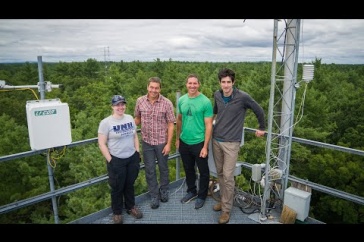
The University of New Hampshire has contributed to a first-of-its-kind new report looking at carbon dioxide (CO2) removal in the United States. Mark Ducey, professor of natural resources and the environment, is one of the researchers from more than a dozen institutions involved in the high-resolution assessment, “Roads to Removal: Options for Carbon Dioxide Removal in the United States,” which charts a path to achieve a net-zero greenhouse gas economy by 2050.
The report, led by researchers at Lawrence Livermore National Laboratory, focuses on steps that can be taken to ensure the nation’s climate security and resilience by cleaning up the Earth’s atmosphere and addressing the root cause of climate change. It also includes an integrated analysis of CO2 removal techniques and resources that are currently available, along with the costs that will be incurred on the path to net-zero.
Ducey was part of the research team that focused on forests which are critical in absorbing CO2 from the atmosphere and storing it. Because of climate change, it is estimated that by the middle of the century the ability of the forests to capture CO2 could decrease by a third. The researchers that focused on forests in the report looked at three different approaches which include increasing forests by planting trees, maintenance and management approaches and building resilience for forests against stressors from climate change, like drought, wildfire, extreme weather and pests.
“All three of these approaches play an important role, but which is most important really depends on what forest we’re talking about and where we are in the country,” said Ducey. “We took a closer look at several areas in the U.S., like the Southeast where we examined expanding forests onto marginally used agriculture land. We also looked at the dry interior West and possible carbon storage benefits to trying to manage trees that are less susceptible to catastrophic fire. In the Northeast, we examined challenges around better timber management, focusing on larger diameter, long lived trees that will offer more durable carbon storage, both as live trees and in the products they provide.”
By using those case examples, the researchers were able to show the carbon benefits, the kind of changes that need to be made and how those depend on local conditions.
In 2022, the United States government established a 2050 goal to reach net-zero emissions by decarbonizing our economy, removing CO2 from the atmosphere and storing it at the gigaton scale (at least a billion tons per year). Roads to Removal lays out a road map to this goal and answers the question: How much CO2 is it possible to remove in the United States and at what cost? The report concludes that with today’s technologies, removing 1 billion metric tons of CO2 per year will annually cost roughly $130 billion in 2050, or about 0.5% of current GDP.
The report says that this ensemble of lowest-cost approaches for CO2 removal would create more than 440,000 long-term jobs and can be achieved using renewable energy sources, with currently available land and below ground geologic storage.
The granular analysis provided in the Roads to Removal report gives decision makers across the United States a lens for location-specific opportunities, enabling them to make decisions that best fit the places they call home. Unlike previous analyses, which used integrated assessment or top-down models, the methods used in Roads to Removal rely on bottom-up calculations and use the most current estimates for resource demands, costs and impacts of potential CO2 removal approaches by county.
The report was jointly commissioned by the U.S. Department of Energy (DOE), Office of Energy Efficiency and Renewable Energy (EERE), Bioenergy Technologies (BETO), the Advanced Research Projects Agency - Energy (ARPA-E), and the Office of Fossil Energy and Carbon Management (FECM), with additional support from the ClimateWorks Foundation.
-
Written By:
Robbin Ray ’82 | UNH Marketing | robbin.ray@unh.edu | 603-862-4864



















































